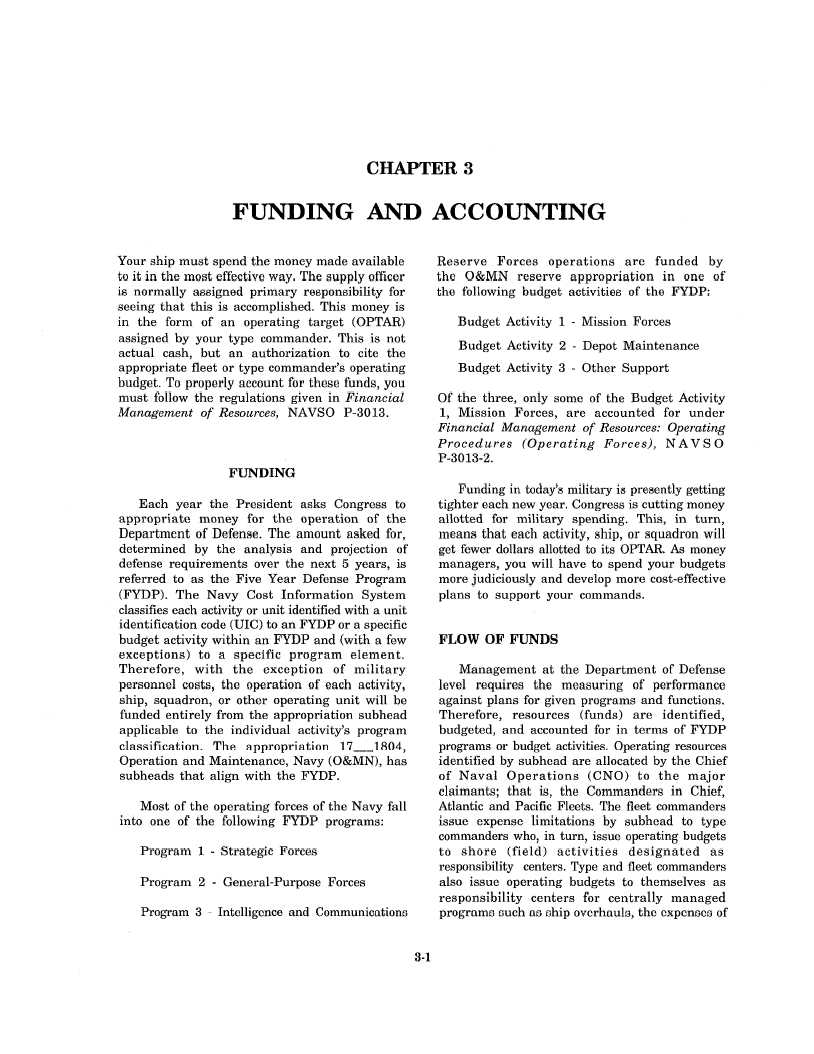| |
FUNDING
AND
Your ship must spend the money made available
to it in the most effective way. The supply officer
is normally
assigned primary
responsibility
for
seeing that this is accomplished. This money is
in the form of an operating
target
(OPTAR)
assigned by your type commander. This is not
actual cash, but an authorization
to cite the
appropriate
fleet or type commander’s operating
budget. To properly account for these funds, you
must follow the regulations
given in Financial
Management
of Resources,
NAVSO
P-3013.
FUNDING
Each year the President
asks Congress to
appropriate
money for the operation
of the
Department
of Defense. The amount asked for,
determined
by the analysis
and projection
of
defense requirements
over the next 5 years, is
referred to as the Five Year Defense Program
(FYDP).
The Navy Cost Information
System
classifies each activity or unit identified with a unit
identification
code (UIC) to an FYDP or a specific
budget activity within
an FYDP and (with a few
exceptions)
to a specific
program
element.
Therefore,
with
the
exception
of military
personnel costs, the operation
of each activity,
ship, squadron, or other operating
unit will be
funded entirely
from the appropriation
subhead
applicable
to the individual
activity’s
program
classification.
The appropriation
17---1804,
Operation and Maintenance,
Navy (O&MN), has
subheads that align with the FYDP.
Most of the operating forces of the Navy fall
into one of the following
FYDP programs:
Program 1 - Strategic Forces
Program 2 - General-Purpose
Forces
Program 3 - Intelligence
and Communications
CHAPTER 3
ACCOUNTING
Reserve
Forces
operations
are funded
by
the O&MN
reserve
appropriation
in one of
the following
budget activities
of the FYDP:
Budget Activity
1 - Mission Forces
Budget Activity
2 - Depot Maintenance
Budget Activity
3 - Other Support
Of the three, only some of the Budget Activity
1, Mission
Forces, are accounted
for under
Financial
Management
of Resources:
Operating
Procedures
(Operating
Forces),
NAVS
0
P-3013-2.
Funding in today’s military is presently getting
tighter each new year. Congress is cutting money
allotted
for military
spending.
This, in turn,
means that each activity,
ship, or squadron will
get fewer dollars allotted to its OPTAR. As money
managers, you will have to spend your budgets
more judiciously
and develop more cost-effective
plans to support your commands.
FLOW OF FUNDS
Management
at the Department
of Defense
level requires
the measuring
of performance
against plans for given programs and functions.
Therefore,
resources
(funds)
are identified,
budgeted, and accounted for in terms of FYDP
programs or budget activities. Operating resources
identified
by subhead are allocated by the Chief
of Naval
Operations
(CNO)
to the major
claimants;
that is, the Commanders
in Chief,
Atlantic and Pacific Fleets. The fleet commanders
issue expense limitations
by subhead to type
commanders who, in turn, issue operating budgets
to shore
(field)
activities
designated
as
responsibility
centers. Type and fleet commanders
also issue operating
budgets to themselves
as
responsibility
centers
for centrally
managed
programs such as ship overhauls, the expenses of
3-1
|

